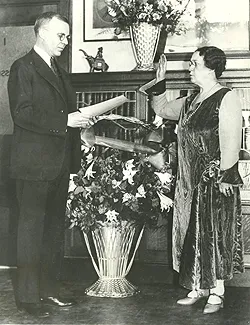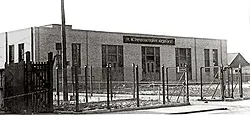The ratification of the 19th Amendment to the U.S. Constitution on Aug. 18, 1920, which granted women the right to vote, also led to the acceptance of women's equality and ability to lead, and gradually opened opportunity for the appointment of qualified women as supervisors and heads of organizations in the federal government.
In 1927, a breakthrough for women was achieved when President Calvin Coolidge appointed Anna C. M. Tillinghast the district commissioner of immigration for the port of Boston. She was the first woman appointed to this position in the Department of Labor's Bureau of Immigration.
Early Life
Tillinghast came to office with an impressive history of accomplishments. Born Anna Churchill Moulton in 1874 in Cicero, N.Y., she attended Tufts College and Emerson College of Oratory in Boston (she was a public speaker when only sixteen), and Brown University in Providence. In 1893, she married James Dannals Tillinghast at the age of 19; they were the parents of Ruth Moulton Tillinghast and James Churchill Tillinghast.

On Feb. 12, 1931, Anna C. M. Tillinghast is sworn-in by Judge Harold Williams for her second four-year term as district commissioner of immigration for the port of Boston.
Photo Credit:International News Photos, New York
Already a practicing lawyer, twenty-five year old James Tillinghast had entered Tufts College Divinity School in 1891, where he presumably met and then married Anna Churchill Moulton. Graduating in 1895, he was ordained in the Universalist ministry and would go on to serve pastorates in Rhode Island, Pennsylvania and Maine between 1895 and 1912.
While the couple were residing In Titusville, Pa., Anna established a girls' club there, and in 1907 she established permanent scholarship of domestic science at nearby Pennsylvania State College (now Pennsylvania State University). She gave the principal address at the dedication of the college's new Woman's Building, and later lectured at the college.
In 1912, the Tillinghasts moved to Beverly, Mass., when James received the call to be pastor at the First Methodist Church there. On March 9, 1913, Anna was also ordained in the Universalist ministry, although she would not serve as a pastor.
In her biography in the 1914-15 Woman's Who's Who of America, Tillinghast listed her seemingly prosaic "Recreations" as: "rowing, swimming, fishing, basket weaving, playing ball and croquet with children."
Suffragist, Prohibitionist and Political Activist
Both Anna and James Tillinghast were active prohibitionists. Anna spoke every day for 10 weeks in a successful campaign to retain the prohibition amendment in Maine's state constitution. At the end of the campaign she was made state lecturer of the Maine Women's Christian Temperance Union, which spearheaded the crusade for prohibition. During the winter of 1911 she lectured on women's suffrage and child labor.
In 1912 Anna organized the Massachusetts Federation of Progressive Women in Boston, and served as president. She was one of three women selected to serve on the Massachusetts State Committee of the Progressive Party, and would serve as Secretary of the organization during the 1914 State Convention.
During the 1912 Presidential campaign, Anna Tillinghast lectured throughout Massachusetts, and gave the Memorial Day oration in Beverly in 1913 - the first woman called to do so in Essex County. She was a member of the Equal Suffrage Association and the Women's Literary Club.
Anna returned to her native state of New York In 1914 to deliver a lecture on among other things: the minimum wage, child labor, eight hour day and equal suffrage, The Auburn Citizen remarked: "She has a pleasing personality and a wonderfully clear voice that reaches both heart and mind. Her subject will be 'Some Remedies for Present Day Problems.'"
In addition to all her social interests and accomplishments, Anna Tillinghast was a committed Republican which led to her appointment as deputy commissioner of immigration at the port of Boston during the Coolidge and Hoover Administrations. Politics would also lead to her removal before the end of her second appointment when Franklin Roosevelt was elected president in 1933. However, her successor was also a woman, Mary H. Ward, who would serve as district commissioner of immigration at the port of Boston until 1940, when the office of the district commissioner of immigration was abolished and its activities were then handled by the district director of immigration and naturalization.
Appointed District Commissioner of Immigration for the port of Boston
Anna Tillinghast was sworn in as district commissioner of immigration for the port of Boston in January 1927; her annual compensation was $5,600. She journeyed to Washington for the ceremony and to meet with Harry E. Hull, the incumbent commissioner general of immigration. A photograph taken the day of the event shows Anna standing with Sen. Frederick H. Gillett (Mass.) and Rep. Edith Nourse Rogers, the first woman from Massachusetts to serve in the U.S. House of Representatives.
Early in her tenure as District Commissioner of Immigration, Mrs. Tillinghast became involved in the deportation proceedings brought against the infamous Italian swindler Charles Ponzi (from whom the term Ponzi scheme descends, and evidenced recently when the "career" of swindler Bernard Madoff went public and sent him off to prison for 150 years), who at that time was serving time in a Massachusetts jail for moral turpitude. The basis for the deportation order was a federal law permitting deportation of convicted criminals. Commenting on the Ponzi warrant, Tillinghast wrote that turpitude was "an act of baseness, vileness or depravity in the private and social duties which man owes to his fellow-men or to society in general, contrary to the accepted and customary rule of right and duty between man and man."

East Boston Immigration Station, 287 Marginal Street. Opened in 1920.
Photo Credit:Boston Public Library
Anna Tillinghast was an alternate-at-large for Cambridge with the Massachusetts delegation to the 1936 Republican National Convention. Little else is known of her activities after her service as District Commissioner of Immigration. She died on New Year's Eve 1951 at the age seventy-seven.
The Immigration Stations at the Port of Boston
In the 1920s Boston was the headquarters of Federal Immigration District 2, which included substations in Gloucester and New Bedford in Massachusetts, Portland, Maine, and Providence, R.I. The processing of immigrants entering America through the port of Boston was handled much differently than at the major immigration stations on Ellis Island in New York Harbor and Angel Island in San Francisco Bay.
Up until 1920, immigrant steerage passengers disembarked at the passenger ships' docks and went through customs and immigration inspection. Those detained were immediately given a hearing before the Board of Special Inquiry. Those immigrants deemed inadmissible were then transported to the U.S. Immigration Station at the end of Boston's Long Wharf. Those admitted at the primary inspection or at the first Board of Special Inquiry hearing, walked out into another area of the steamship dock where they would receive their baggage and then proceed directly to the city proper or Boston suburbs. Those passengers bound for the West were placed aboard special trains or special cars with destinations outside of the Boston area.
The immigrant station at the end of Long Wharf was located on the second floor of an aged freight shed, long considered an unsafe fire trap. The wretched conditions of the station created an unhealthy and unsanitary environment for the federal inspectors and for the care and detention of those immigrants deemed inadmissible and/or awaiting deportation.
By 1907, plans were underway to build a new immigration station in Boston, and Congress appropriated $250,000 for site acquisition and construction of a new fireproof facility. Local authorities were in opposition to suggestions the new station should be situated on either Castle Island or Governors Island in Boston Harbor. Agreement was finally reached in March 1911, and the federal government purchased approximately 1.6 acres of combined infilled land and marsh flats at 287 Marginal Street in East Boston from the East Boston Company.
It would be another nine years before the station was completed. The building could accommodate 582 immigrants and contained detention facilities, separate dormitories for men and women, recreation and dining rooms, baggage storage, Public Health Service examination rooms and offices, a rooftop exercise area, processing areas and offices for Bureau of Immigration officials, including Tillinghast's office.
During World War II the East Boston station was used for the detention of individuals deemed potential threats to national security, including the crews of two ships from Germany and Italy that were seized in March 1941, and a crew of Nazi operatives captured off the coast of Greenland in 1941.
In 1950 an Immigration and Naturalization Service office was opened at 73 Tremont Street in Boston, although the detention function remained in the East Boston station.
The Beginning of the End
After only thirty-four years of operation, the East Boston Immigration Center was closed down in 1954 and declared surplus. GSA sold the building in 1959. The current owners, Massport (Massachusetts Port Authority) has recently proposed to demolish the building in order to provide vessel repair lay down space for the Boston Harbor shipyard.
Local preservationists campaigned vigorously to have the station declared a Boston Landmark and restored. In July 2010, a Study Report was issued by the Boston Landmarks Commission that found the East Boston Immigration Station met the criteria for Landmark designation "as a structure at which events occurred that have made an outstanding contribution to, and are identified predominantly with, an important aspect of the cultural, political, economic and social history of the city (Boston), the Commonwealth, the New England region, and the nation."
The report went on to state, "However, due to the deteriorated condition of the building, the lack of architectural integrity and loss of what minimal detail it once possessed, combined with very limited potential for adaptive reuse due to the building's large size, stringent zoning restrictions, and the restrictive grid of interior structural columns, the staff withholds recommendation to designate the East Boston Immigration Station as a Landmark."
Massport has issued notice the East Boston Immigration Station will be demolished during the summer of 2011.

